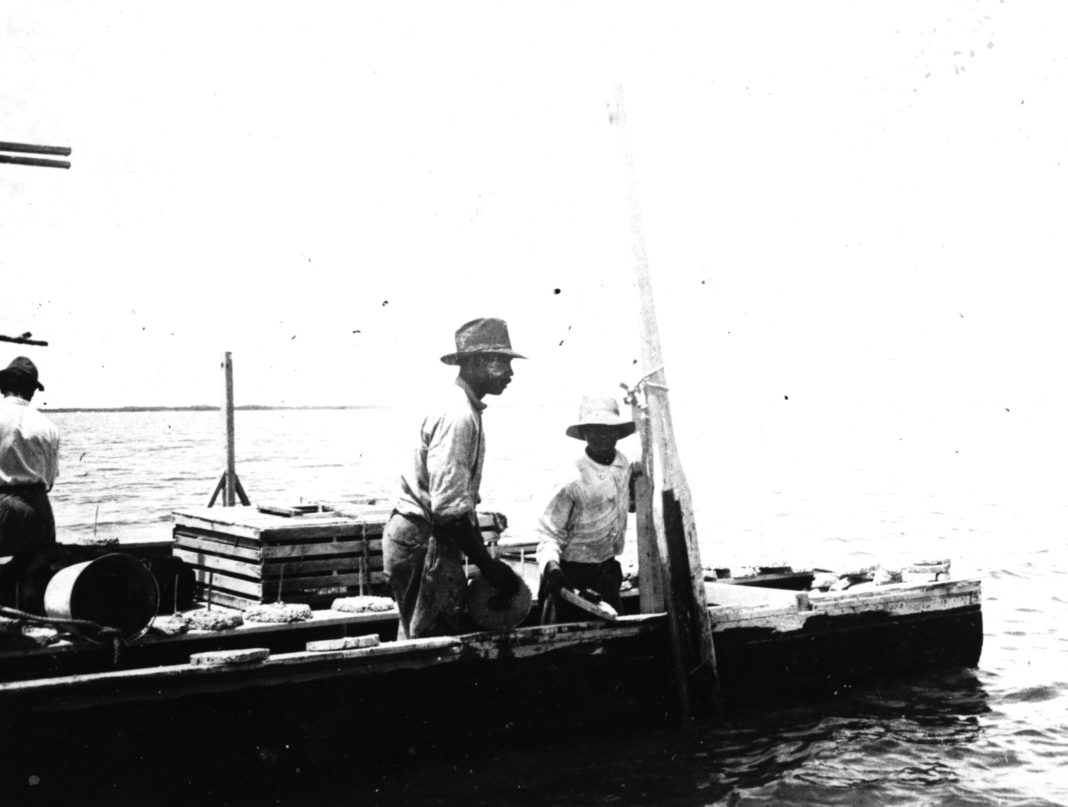Dr. J. Vining Harris of Key West began experimenting with the cultivation of sponges at his Sugarloaf Key property in 1897. Circa 1901, Harris abandoned his sponges and allowed H. F. Moore, the head of the United States Bureau of Fisheries, who, like Harris, was interested in farm-raising sponges, to move into his house and operate his sponge experiments from the Sugarloaf Key property.
After studying the propagation of the sponge for several years and declaring it a feasible operation, he, too, left Sugarloaf Key. It would not be the end of sponge operations on the island.
Charles Chase stepped in and filled their shoes. Chase had been visiting Key West from London when he learned of Dr. Moore and his work with sponge cultivation. With his interest piqued, Chase partnered with his brother George and a friend named Henry Bate, and the group purchased the Sugarloaf Key property from Harris and developed The Florida Keys Sponge and Fruit Company. In addition to the sponges growing in the shallows surrounding the island, the company planted Key lime and fig trees.
In an article from the Miami Herald dated June 9, 1915, Chase made the following statement about his work at Sugarloaf Key. “We were led to go into this interesting and promising business through the eight years of successful experimental work done by Dr. H.F. Moore of the fisheries bureau of the United States government, and to him we are largely indebted for our success. Dr. Moore demonstrated that sponges could be advantageously grown only where there is complete absence of fresh water, where water is of the right temperature and salinity, where they can be protected from marauders, and where there is freedom from sand, and water is shallow enough to make planting and handling a matter of not too great difficulty.”
Chase’s company quickly grew, and by 1912, a community of about 100 people was living near the area of what is today the Sugarloaf Lodge at MM 17. Many of the community members worked for Chase and his company. The community had homes for the workers, a store, a boat repair shed, a refrigeration plant and – a rarity in the Florida Keys – a telephone. After Henry Flagler’s train made it to Key West in 1912, a depot was established at Sugarloaf Key. To satisfy the needs of the small community that grew up around Chase’s sponge farm, he petitioned to establish a post office. With the approval of the post office, named after Charles Chase, who was also named postmaster, the postal address and town of Chase, Florida, came into existence.
The Florida Keys Sponge and Fruit Company was off to a promising start, and the Chase farm of sheepswool sponges was maturing nicely offshore. By 1915, Chase and his company had about 5,000 acres of sponge beds. “A crew of 12 operating from a barge and pontoons alongside it,” Chase said, “could plant 5,000 sponges per day.”
The Florida Keys Sponge and Fruit Company had some 650,000 sponges growing in 3-4 feet of water, an ideal depth for cultivation. The Chase sponges improved on the efforts of Harris and Moore and managed to drop the mortality rate to less than 5%. The company’s sponges growing offshore ranged from 1 to 3 years old, and they needed to be at least 3 to 4 years old before they could be commercially harvested, and maybe even a little older before they were ready. By 1915, about 170,000 sponges were on the cusp of commercial maturity.
The company shipped a bale of the sponges to the Chicago firm Peter Van Schaak & Sons to be quality tested. The results were “pre-eminently satisfactory, demonstrating that the Chase sponge is greatly superior to the ordinary sheepswool sponge.” The problem for the partners and the company was that they were running out of capital and needed investors to keep their operation moving forward. The Chase brothers took a trip to England to raise funds, and, at first, they were successful. When World War I broke out, however, the funds were frozen, and the Chase brothers returned to Sugarloaf Key empty-handed. Without the capital necessary to continue their work at The Florida Keys Sponge and Fruit Company, it was decided to cease operations.
After they did, poachers swiped the mature sponges from the shallows surrounding Sugarloaf Key. In May 1917, The Florida Keys Sponge and Fruit Company declared bankruptcy. Then, a Miami Beach real estate investor named Clyde Richter Perky purchased the business and 23,000 acres of Monroe County property, including the Sugarloaf Key property. While he initially intended to try to reinvigorate the sponge and fruit business, he turned his eye to the burgeoning tourist industry and developed a fishing camp instead. He also built the world-famous Perky Bat Tower, but that is a story for another day.
Part 3 of this series will explore the sponge war that erupted between Key West and Tarpon Springs, on Florida’s west coast. Stay tuned for more in next week’s Keys Weekly.





















